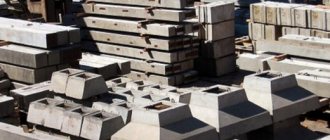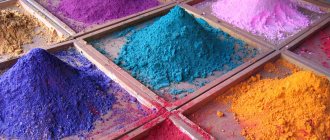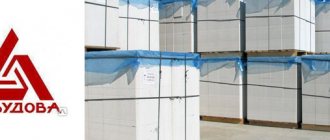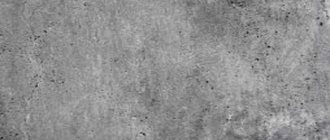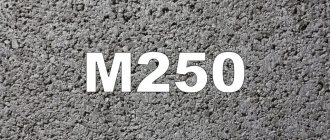The brand and class of the concrete mixture are taken into account when choosing the optimal type of structural material for certain construction work. The strength characteristics of finished reinforced concrete structures directly depend on the parameters of the concrete composition. The concepts of class and grade of concrete are used almost in parallel when denoting the main characteristics of the material. The strength of concreted structures reaches design parameters 28 days after laying the liquid mixture.
Concrete grades and their characteristics
The determining criterion for the type of grade is the amount of cement in the concrete mixture, on which its hardness depends. Thus, the designation “grade M200” will mean that this concrete product will withstand a pressure of 200 kgf/cm2, that is, it has a compressive strength of 200 kgf/cm2. Class “B” concrete, like the grade, reflects the compressive strength of the material, but more precisely defines this parameter. The difference between class B concrete and grade M lies in the method for determining the strength characteristics of the material.
In documentation, concrete material is usually characterized by a class, but in real construction the use of the brand designation has not yet been abandoned. Compliance with the brand and class of concrete is regulated by GOST 26633-91.
The full designation of the concrete class looks like a combination of the letter “B” and a number indicating the maximum possible compressive force, expressed in megapascals. For example, “B45” reports that the concrete product will withstand a pressure of 45 MPa. The reliability coefficient for the concrete class is 0.95.
Correlation between brand and strength class of concrete
| Concrete class | Average compressive strength of this class | Nearest brand of concrete | |
| kgf/cm2 | N/mm2 | ||
| V 3.5 | 46 | 4,5 | M50 |
| B 5 | 65 | 6,2 | M75 |
| B 7.5 | 98 | 9,5 | M100 |
| B 10 | 131 | 13 | M150 |
| At 12.5 | 164 | 16 | M150 |
| B 15 | 196 | 19 | M200 |
| IN 20 | 262 | 25 | M250 |
| B 25 | 327 | 30 | M350 |
| At 30 | 393 | 36 | M400 |
| B 35 | 458 | 43 | M450 |
| At 40 | 524 | 50 | M550 |
| B 45 | 589 | 56 | M600 |
| At 50 | 655 | 63 | M600 |
| B 55 | 720 | 70 | M700 |
| At 60 | 786 | 76 | M800 |
On a note! There is a term “concrete grade for tensile strength”, however, it is indicated only when this particular parameter plays a key role in the future structure.
Mixture composition
Concrete grade M200 has basic components that are always constant, and variables that determine its performance properties. The main component is cement. For grade M200, the composition uses Portland cement M400-500.
A mandatory ingredient is dry sifted sand, up to 3.5 mm in size, without impurities. It determines the plasticity of the solution.
The obligatory filler is crushed stone or gravel, up to 80 mm in size.
The water content in the composition is 20%.
Additives - plasticizers - improve frost resistance and water permeability.
Transition from concrete brand to class
For example, the conversion of concrete class to grade can be done by referring to the table of concrete classification by grade and class:
| Concrete strength class (C) according to DBN | Concrete strength class (B) according to SNiP | Average strength of concrete of this class R | The closest grade of concrete in terms of strength is M, kgf/cm2 | Deviation of the nearest grade of concrete from the average strength of class R - M / R * 100% | |
| MPa | kg/cm2 | ||||
| — | B0.35 | 0,49 | 5,01 | M5 | +0,2 |
| — | B0.75 | 1,06 | 10,85 | M10 | +7,8 |
| — | IN 1 | 1,42 | 14,47 | M15 | -0,2 |
| — | B1.5 | 2,05 | 20,85 | M25 | -1,9 |
| — | AT 2 | 2,84 | 28,94 | M25 | +13,6 |
| — | B2.5 | 3,21 | 32,74 | M35 | -6,9 |
| — | B3.5 | 4,50 | 45,84 | M50 | -9,1 |
| — | AT 5 | 6,42 | 65,48 | M75 | -14,5 |
| — | B7.5 | 9,64 | 98,23 | M100 | -1,8 |
| S8/10 | AT 10 | 12,85 | 130,97 | M150 | -14,5 |
| C10/12.5 | B12.5 | 16,10 | 163,71 | M150 | +8,4 |
| C12/15 | B15 | 19,27 | 196,45 | M200 | -1,8 |
| C16/20 | IN 20 | 25,70 | 261,93 | M250 | +4,5 |
| C18/22.5 | B22.5 | 28,90 | 294,5 | M300 | +1,9 |
| C20/25 | B25 | 32,40 | 327,42 | M350 | -6,9 |
| C25/30 | B30 | 38,54 | 392,90 | M400 | -1,8 |
| C28/35 | B35 | 44,96 | 458,39 | M450 | +1,8 |
| C32/40 | B40 | 51,39 | 523,87 | M550 | -5,1 |
| C35/45 | B45 | 57,82 | 589,4 | M600 | +1,8 |
| C40/50 | B50 | 64,24 | 654,8 | M700 | +6,9 |
| C45/55 | B55 | 70,66 | 720,3 | M700 | -2,8 |
The ratio of the number in the designation of concrete class (not grade) and strength is expressed through a coefficient of 13.5%. The table indicates the parameter R, indicating the average strength. This parameter can be calculated if you do not have a table of correspondence between concrete classes and grades at hand. The formula is as follows:
R = V: (0.0980665 * (1- 1.64 * v)),
where B is the compression value in the class, v = V: 100 = 13.5: 100 = 0.135, 0.0980665 = conversion coefficient from the MPa system to the kgf/cm2 system
It must be remembered that strength for a class of concrete is expressed in MPa, and for grades - in kgf/cm2. The calculation result will show that the average strength for class B10 will be equal to 131 kgf/cm2
Concrete M250
Experienced builders know what material needs to be used for certain work, therefore, when choosing a brand of concrete, they proceed from the type of installation work and the scope of its application.
Concrete M250 occupies an intermediate position between the popular M 200 and M 300 and is used for the manufacture of strip, monolithic, pile-grillage and slab foundations for low-rise construction. This composition is also suitable for the construction of fence strips, stairs, concrete blind areas, paths, light-loaded floor slabs, retaining walls, platforms and other light-loaded structures. Despite the good characteristics, the demand for this material is very modest. Concrete grade M-250 class B 20 is made on gravel, granite or crushed limestone. Frost resistance of the material on granite crushed stone is F 200, and on limestone crushed stone F 50. The water resistance of the mixture on granite crushed stone is W8, and on limestone crushed stone W2. The mobility indicator of the composition can vary from p1 to p4.
New designation for concrete classification
In the table of correspondence between grades and classes of concrete given above, in the first column there are new class designations that came from the European Union. Previously, designations like B25 were used. In the new concrete classification this will be designated as C20/25.
How did such an abbreviation come about? In some EU countries (England and others), to determine the compressive strength of concrete products, a cylinder is used whose height is twice the diameter. And in other countries, a concrete cube is used for these purposes. Due to differences in sample shape and weight, strength values will vary.
Decoding concrete class C20/25 will mean:
- cube compressive strength 25 MPa;
- the compressive strength of the cylinder is 20 MPa. Concrete C20/25 means B25, and which brand will correspond can be found in the table decoding the concrete brand and their characteristics.
A new system of conformity and designation of concrete classes is used, but the usual “B10-B1000” are used more often. To fully assess the type of material, other important technical characteristics are used: water resistance and frost resistance.
Application
Concrete M200 is lightweight. Used for pouring screeds and leveling various surfaces. Used for the manufacture of reinforced concrete structures, such as blocks for foundations, floor slabs, flights of stairs.
In low-rise construction, during the construction of outbuildings and brick fences, this material is used for the construction of shallow foundations.
Production of paving slabs using concrete grade M200. They are highly reliable, can withstand temperature changes and do not require extra costs.
The use of concrete is determined by the fractions of crushed stone included in it. The fine-grained composition is used for products formed in small formworks. This mixture spreads evenly over the mold and makes it possible to obtain small structures. These are lintels, elements of stairs.
The area of application of the coarse-grained composition is the construction of strip foundations, walls, reinforced concrete structures.
Waterproof
Water entering microcracks in a concrete structure can lead to significant damage during subsequent freezing. Water resistance is measured by the level of one-way hydrostatic pressure (kgf/cm²), when the sample does not allow moisture to pass through.
Seals and hydrophobic additives can improve water resistance. The cost of a concrete mixture with high water resistance is significantly higher. But a concrete structure made from such a mixture does not need waterproofing and will last longer. It is from waterproof material that pedestrian paths, concrete fortifications, curbs and other objects that are constantly exposed to the external environment are made.
The moisture resistance of the material is determined by the water-cement ratio in the composition and the filtration coefficient. According to GOST, there are 10 levels of water resistance: W2, W4, W6, W8, W10, W12, W16, W14, W18, W20. Impermeability means that a concrete sample 15 cm high will withstand a certain maximum water pressure under standard conditions.
Depending on moisture permeability, the concrete mixture is classified into three categories:
- “N” – normal moisture resistance W2-W4;
- “P” - reduced permeability W4-W6;
- “O” – particularly low moisture permeability W8 – W20.
The most resistant to water is the W20 brand. However, due to the high cost, W10-W20 is used only on fundamental construction sites: the construction of bunkers, hydraulic facilities, and reservoirs. These types have another important quality: frost resistance.
Producing high-quality waterproof concrete
For this purpose the following methods are used:
- High-strength cement M600-M1000 is used, which, when hydrated, absorbs water much more than other types of cement. As a result, a dense stone-like mass is formed;
- Air-entraining fillers are added to the concrete mixture: aluminum or iron sulfates, which increase the compaction of the material during laying;
- plasticizers are used to reduce the water-cement ratio;
- Waterproofing components are added to the concrete mixture.
Water permeability
The structure of concrete structures has pores and capillaries. The higher the open porosity, the greater the water permeability. For aerated concrete it reaches 25%. Dense structural concrete has the lowest water permeability. The class is designated by the letter “W”.
In order to increase moisture resistance and frost resistance, plasticizers and modifiers are additionally used.
Incorrect calculation, selection of concrete mixture components, or excess water increases the water permeability of the material. During the process of concrete mixture shrinking and hardening, micro cavities are formed, which over time can fill with moisture. Therefore, at the time of pouring, compaction is carried out using vibrators to avoid the formation of air voids.
Classification of concrete according to strength class, frost resistance, water permeability (table):
| Concrete grade | Concrete class | Waterproof (W) |
| M100 | B7.5 | W2 |
| M150 | B12.5 | W2 |
| M200 | B15 | W4 |
| M250 | IN 20 | W4 |
| M300 | B22.5 | W6 |
| M350 | B25 | W8 |
| M400 | B30 | W10 |
| M450 | B35 | W8-W14 |
| M550 | B40 | W10-W16 |
| M600 | B45 | W12-W18 |
Frost resistance
The packaging of the material is marked with appropriate markings indicating the degree of frost resistance. This property is determined by the number of freezing/thawing cycles during which the material is deformed. A sample of the material is immersed in water or a special solution, kept there until completely absorbed, then frozen to -18 degrees. Periodically measure how much strength the material has lost. After completing a number of cycles, the frost resistance index is determined.
Frost resistance marking
According to GOST, frost resistance is marked as follows: F50, F100, F150, F200, F300, and these grades are grouped according to the following scheme:
- Less than F50: low level of frost resistance, used extremely rarely.
- F50 - F100: moderate, widely used in construction.
- F150, F200: increased frost resistance, withstands strong temperature changes.
- F300 - F500: high frost resistance, used in particularly difficult conditions.
- Above F500: increased frost resistance, used in rare cases. High-quality cement is used in the mixture and special substances are added.
How to calculate proportions for making solutions
An important feature to pay attention to. The rule “a lot of rash to make it stronger” does not apply in this case.
Overconsumption of cement raw materials represents direct losses for the manufacturer. In addition, ill-considered addition of binders and other concrete components will ultimately produce a product with unpredictable features. The consequences of such experiments can be very sad.
The technical conditions for the production of concrete solutions are determined by GOST, and the amount of cement raw materials is regulated by the requirements of SNiP. From a practical point of view, it is much more convenient to use small “extracts” from technological documents compiled by concrete manufacturing specialists.
To prepare the concrete in question, raw materials are taken in the following proportions:
How to determine the strength of ready-mixed concrete
There are several ways to diagnose the strength characteristics of a concrete structure. The most common definition of strength is the method of chipping. But there are other ways:
- Non-destructive testing using special devices.
- Method of local destruction.
- With the impact method, impact energy is recorded when the equipment and surface come into contact.
- Ultrasonic method using a wave sensor.
- Destructive methods involving the removal of fragments from a concrete structure.
What factors affect the strength of concrete?
The strength of the concrete mixture depends on the water-cement ratio. The most common ratio used in practice: 0.3:0.5. With a lower value, the solution will acquire low plasticity; with a larger value, the mobility will improve, but the strength will decrease. The quality of a cement-based concrete mixture depends not only on the incoming components, but also on their ratio.
Composition of concrete by grade and class table
Attention! The more cement contained in the concrete mixture, the higher the grade and strength of the concrete structure.
What is the difference between concrete m200 and m300: use of the material, taking into account the differences
No construction process is complete without concrete mortar. This material is used to create the most important structures - foundations, columns, floor elements and support beams. Without knowing the physical characteristics and proportional relationships of raw materials, a private owner is not recommended to even begin its production. Today we’ll look at how concrete M200 differs from M300, we’ll study the technical features of each composition, and we’ll show you how to prepare the required solution yourself.
Standards and test methods
Our company's products are manufactured in our own production facilities in strict accordance with GOST 26633-2015 “Heavy and fine-grained concrete. Technical conditions". Another document regulating the production of concrete mixtures is GOST 7473-2010, which applies to all types of mixtures and contains a list of standards for various types of concrete, its ingredients and other standards.
We use modern equipment that controls the weight and moisture content of the components during the technological process. The quality of the mixture components is checked in our own laboratory according to the relevant GOSTs. Strength testing is carried out in the laboratory using a destructive method in accordance with GOST 10180-90 “Concrete. Methods for determining strength using control samples." The method consists of applying compression to control samples provided by the client. Non-destructive testing is carried out using an electronic device IPS-MG 4.03 at the construction stages and during the operation of facilities.



